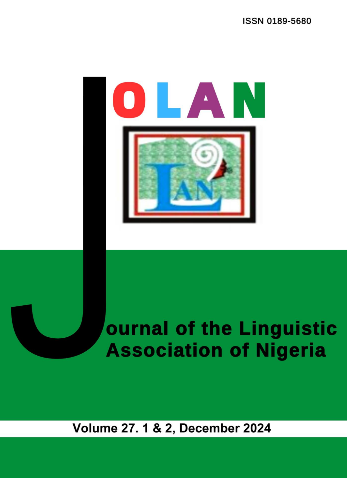The Humour Techniques of BBC’s “Letter from the President”: An Insight
Keywords:
comic locus, genus, humour, inference, pragmaticsAbstract
This paper examines the relevance of pragmatic considerations to the explication of humorous discourse. The “Letter from the President” column of BBC Focus on Africa Magazine is taken as the reference data. The incongruity theory of humour in it various manifestations is subscribed to in examining the relevance of juxtaposing linguistic and situational factors in humour creation. The analyses found that the key to the humour
in all these situations in the extracts lies in juxtaposing several discordant linguistic or situational elements. Lexical items are not given their usual collocations but serve as tools that reflect words or expressions in the language or allude to references in the extra-linguistic world. This explains the fact that the language of humour necessarily involves the integration of linguistic code and contextual elements. The latter is more important here because whereas a given physical movement can produce laughter, it is inconceivable for a linguistic item to produce hilarity exclusively by itself.
References
Consalvo, C. M. (1989). “Humour in Management: No Laughing Matter”. Humour, Volume II, Number 3: 285-97
Coulthart, M. (1977). An Introduction to Discourse Analysis. London: Longman Group Ltd.
Hodge, R. and Kress, G. (1988). Language as Ideology. London: Routledge.
Holmes, J. (2000). “Politeness power and provocation: how humour functions in the workplace” Discourse Studies Vol.2 No.2: 159 – 185.
Koestler, A. (1989). “Humour and Wit” The New Encyclopaedia Britannica, Macropaedia Knowledge in-depth. (15th edition, Vol. 20: 739-745). Chicago: University of Chicago.
Leech, G. N. (1983). Principles of Pragmatics. London: Longman.
Levinson, S. C. (1983). Pragmatics. London: Cambridge University Press.
Metzger, M. and Bahan, B. (2001). “Discourse Analysis” in Lucas, C. (2001) (ed, pp. 113-121), The Sociology of Sign Language. London: Cambridge University Press.
Mulkay, M. (1988). On Humour: its Nature and Its Place in Modern Society. Oxford: Polity Press.
Nash, W. (1985). The Language of Humour: Style and Technique in Comic Discourse. New York: Longman Group Inc.
Norrick, N. (1993). Conversational Joking: Humour in Everyday Talk. Bloomington, Indiana: Indiana University Press.
Palmer, F. R. (1982). Semantics. Cambridge: Cambridge University Press.
Raskin, V. (1994). ‘Humour’ in Asher, R.E. (ed, pp. 1616-1620), The Encyclopaedia of Language Volume 3,
Sacks, H. G. (1989). “An Analysis of the Course of a Joke’s Telling in Conversation” in Bauman, R. and Sherzer, J. (eds, pp. 337- 53) Explorations in the Ethnography of Speaking. Cambridge: Cambridge University Press.
Yule, G. (1985). The Study of Language. London: Cambridge University Press.
Hurley, Matthew M., Dennet, D. C., and Adams, R. B. Jr. (2011). Inside Jokes: Using Humor to Reverse-Engineer the Mind. Massachusetts: MIT Press.
Marteinson, P. (2006). On the Problem of the Comic. Ottawa: Legas Press.
Suslov, I. M. (1992). “Computer Model of a Sense of Humour: Realization in Neural Networks”. Biofizika SSSR 37, 325 http://arxiv.org/abs/0711.2061. Accessed June 2015.














